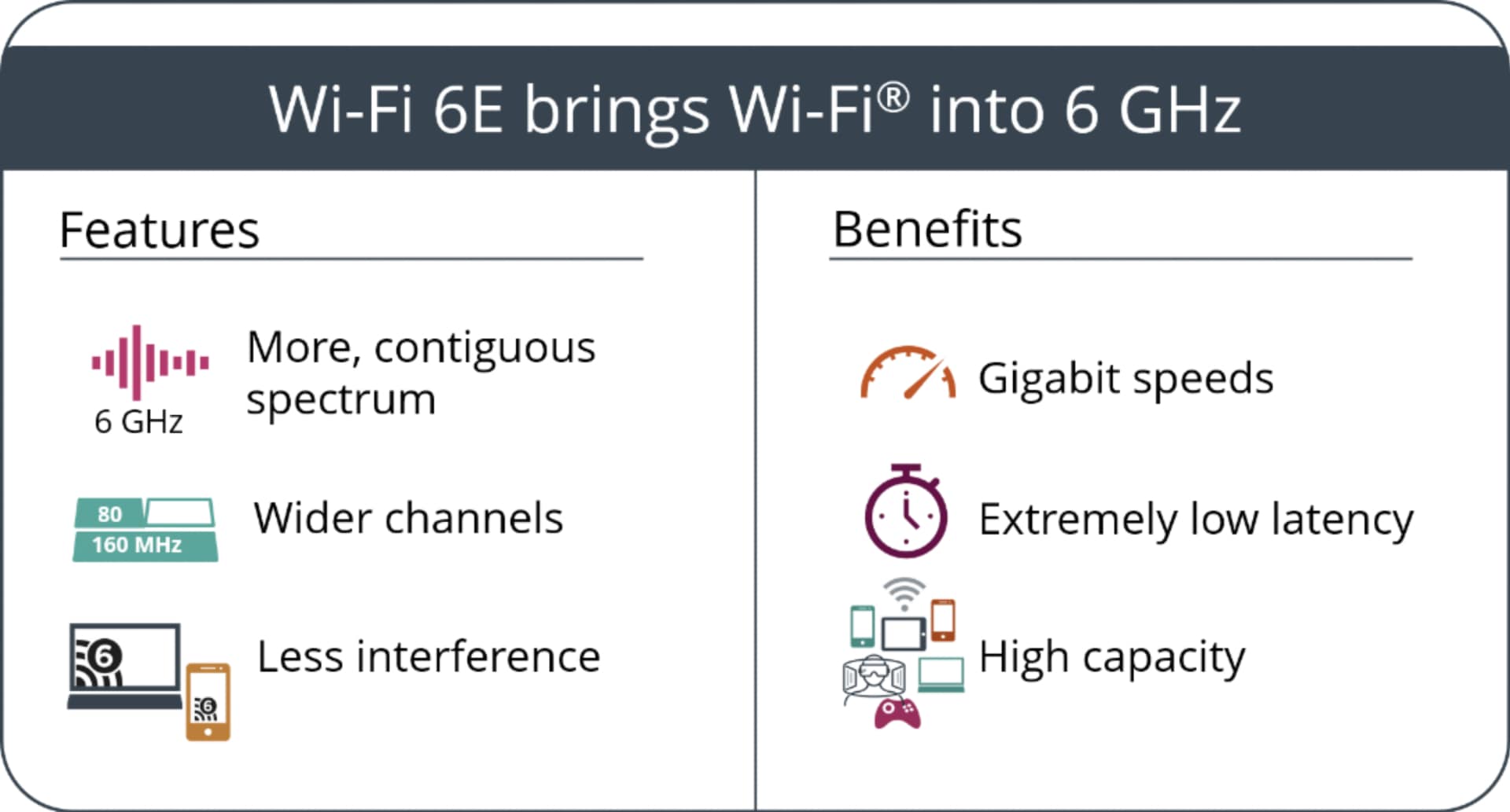May 04, 2021
Are You Ready for the Wi-Fi 6E Rollout?
With more widespread deployment looming, it’s a good time to make sure you are organized to take advantage of this technology.

Last August, I wrote about changes with Wi-Fi 6E. Now, nine months later, it’s worth a quick revisit as we’re on the cusp of seeing releases from major enterprise vendors.
Learn about CDW’s wireless solutions and services.
Wi-Fi 6E Benefits Refresher
 Source: wi-fi.org
Source: wi-fi.org
At the heart of the new standard is the 1,200MHz of spectrum that will be made available. Even without diving into additional features, more spectrum equals more channels, which means less likelihood of interference from other Wi-Fi devices.
This is an oversimplification, but I cannot stress enough how impactful the additional band will be overall. Unlike some other standards, such as 802.11ad, which was not widely adopted, I predict the industry will rapidly adopt Wi-Fi 6E in order to leverage this nearly greenfield space.
Typically, faster Wi-Fi is directly related to utilizing wider channels, and with the added spectrum it’s likely we’ll see greater adoption of 40MHz and 80MHz channels. With Wi-Fi 6 and earlier, one of the major issues with wider channels (aside from limited spectrum) is that doubling the channel bandwidth also doubles the noise floor. In dense environments, this becomes very problematic as the client now needs to overcome the additional noise floor in order to have effective communication with the access point (AP).
This is where 6E shines with the addition of Power Spectral Density (PSD), which allows for increased power limits as channel widths increase. As the power increase can now keep up with the noise floor, this feature removes the noise stigma from using wider channels. This consideration, along with other power changes, is new for many people so I advise reviewing some other blogs posts to understand PSD and new power restrictions.
Another benefit (depending on your viewpoint) is that 6E will support 802.11ax only and drop 802.11a/b/g/n/ac devices entirely. I’m framing this as a benefit because the previous requirement to be backwards compatible with former generations has often hampered new efficiencies. A slightly dated but well-known example is that any clients that still require 802.11b will slow down the network significantly due to the modulation change and greater time on air. Without these shackles, 6E will have little problem leveraging OFDMA and other capabilities that come with WiFi 6 (802.11ax).
Wi-Fi 6E Rollout – The Details Matter
As with any new standard, there are always considerations to go with the shiny new features. Several of these “gotchas” are very similar to obstacles you’ve likely encountered before.
Back in 2016, the FCC changed some rules allowing for greater power and outdoor use in UNII-1 and an addition of channels in the Terminal Doppler Weather Radar (TDWR) bands. Vendors rapidly released access points that could take advantage of the “new” seven channels in the 5GHz band. Typical adoption paths driven by end-of-life (EOL)/end-of-sale (EOS) hardware, coincidental 3-5 year purchasing cycles and early adopters were accelerated with the new APs.
What we saw in the field was that unless proper planning and precautions were taken, this could create “holes” in an RF environment. Wireless clients that were not also upgraded at this time would be unable to see these new channels in the environment, which could cause roaming and connectivity problems. In larger environments with multiple sites, this could cause even more problems if the new channels were not selectively enabled to match a site’s client capabilities.
All these potential pitfalls will again be present with a 6E rollout, but instead of a few new channels, we’ll be looking at a complete new wireless band with a potential of (59) 20MHz-wide channels. Fortunately, a mitigation will likely exist in the form of tri-band access points from the various vendors. This will at least allow devices that are not yet 6E capable to cooperate while device proliferation occurs.
As I’ve stated before, it’s always better to attempt to update client devices near the time that APs are updated to help accelerate this adoption. No matter what, extra care needs to be taken when doing 6E RF planning so that the organization’s expectations can be set and met accordingly.
Finally, 2016 highlighted that this change was from the FCC, meaning this change was only applicable to the United States and its territories. The additional spectrum for 6E is similar in that other regulating bodies are making their own determination as to what channels and frequencies will be supported. This is especially important for global organizations who are considering how they may (or may not) be able to leverage 6E across their various locations. Global availability continues to evolve and there are several white papers and blogs that address these considerations in more depth.
Infrastructure Upgrade Timing
I apologize for sounding like a broken record on my blogs posts over the last year, but I will say it again: Now is the time to review your wired infrastructure capabilities and upgrade so you can take full advantage of 6E.
Tri-band radios will undoubtedly require more power to operate at full capacity, so switches should at minimum be able to supply 802.3at (25.5W) power with preference to being able to support 802.3bt (90W). The long-heard promises of saturating the 1-Gigabit Ethernet port over Wi-Fi are finally a reality, especially if bandwidth hungry devices like VR headsets are riding on the wireless. While it’s yet to be seen if the vendors will opt for multiple network interfaces or 802.3bz (HPE Smart Rate/Cisco mGig) on a single port, history from Cisco and Aruba has shown us that the single port has been preferred.
Device Availability
At the time of writing, vendors like Cisco and Aruba have been hesitant to announce any 6E capable access points for 2021. The current sentiment in the industry is that we could hear some announcements from those vendors near the end of the year, after the FCC issues a second report and order. The usual chip manufacturers (Broadcom, Qualcomm, On Semi, ASUS, Intel) all have an option, and so we’ve already seen early releases in the form of Intel’s laptop ready AX210, the Asus GT-AXE11000 gaming router and Samsung’s Galaxy S21 Ultra. Additionally, as more devices start to land, the Wi-Fi Alliance has a page of certified devices with 6 GHz capabilities that will be a good ongoing reference as the landscape increases. Needless to say, the doors to Wi-Fi 6E are opening, and if you are an early adopter you don’t have much more time to wait.
For help in navigating this new territory, CDW is ready to assist with all your technology needs.

